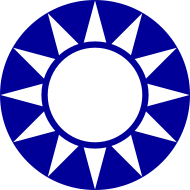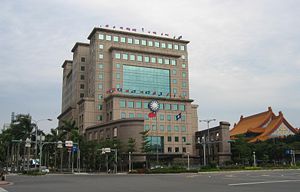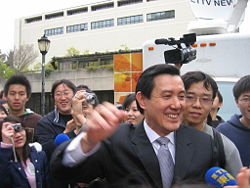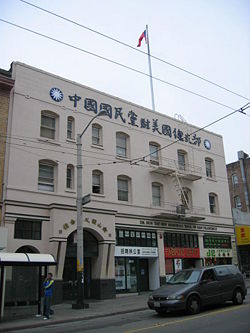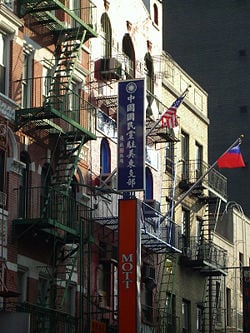Kuomintang
| Kuomintang of China 中國國民黨 中国国民党 | |
|---|---|
| Chairman | Wu Po-hsiung |
| Founded | 1919-10-10 (modern) 1894-11-24 (as Revive China Society) |
| Headquarters | 232-234 Bade Rd., Sec. 2 Zhongshan District, Taipei City, Taiwan, Republic of China |
| Official newspaper | Central Daily News |
| Membership (2006) | 1,089,000 |
| Official ideology/ political position |
Three Principles of the People, Conservatism, Anti-communism, Centre-right, Chinese nationalism, Chinese reunification. |
| International affiliation | International Democrat Union |
| Official color(s) | Blue |
| Website | www.kmt.org.tw |
The Kuomintang of China (abbreviation KMT) [1], also often translated as the Chinese Nationalist Party, is a political party in the Republic of China (ROC), now on Taiwan, and is currently the largest political party in terms of seats in the Legislative Yuan, and the oldest political party in the Republic of China. The KMT is a member of the International Democrat Union.
Together with the People First Party and Chinese New Party, the KMT forms what is known as the Taiwanese Pan-Blue coalition, which support eventual reunification with the mainland. However, the KMT has been forced to moderate their stance by advocating political and legal status quo of modern Taiwan.
The KMT originated in China in 1912 , founded by Song Jiaoren and Sun Yat-sen shortly after the Xinhai Revolution. Later led by Chiang Kai-shek, it ruled much of China from 1928 until its retreat to Taiwan in 1949 after defeat by the Communist Party of China (CPC). There, the KMT controlled the government under a single party state until reforms in the late 1970s through the 1990s loosened its grip on power. The ROC was once referred to synonymously with the KMT and known simply as "Nationalist China" after its ruling party.
Support
Support for the Kuomintang on the Republic of China encompasses a wide range of groups. Kuomintang support tends to be higher in northern Taiwan and in urban areas, where it draws its backing from small to medium and self-employed business owners, who make up the majority of commercial interests in Taiwan. Big businesses are also likely to support the KMT because of its policy of maintaining commercial links with mainland China. The KMT also has strong support in the labor sector because of the many labor benefits and insurance implemented while the KMT was in power. The KMT traditionally has strong cooperation with labor unions, teachers, and government workers. Among the ethnic groups in Taiwan, the KMT has solid support among mainlanders and their descendants for ideological reasons and among Taiwanese aboriginals.
Opponents of the KMT include strong supporters of Taiwan independence, people of Hoklo (Hokkien) background, and rural residents, though supporters of unification include Hoklo and supporters of independence include mainlanders.[citation needed] There is opposition due to an image of KMT both as a mainlanders' and a Chinese nationalist party out of touch with local values. In addition, many oppose the KMT on the basis of its authoritarian past, large amount of party assets, alleged corruption, and patronage networks.[citation needed]
History
Early years
The Kuomintang was founded in Guangdong Province on August 25, 1912 from a collection of several revolutionary groups that had successfully overthrown the Qing Dynasty in the Xinhai Revolution, including the Revolutionary Alliance, as a moderate democratic socialist party. Thus, the party traces its roots to the Revive China Society, which was founded in 1895 and merged with several other anti-monarchist societies as the Revolutionary Alliance in 1905.
Sun Yat-sen, who had just stepped down as provisional president of the Republic of China, was chosen as its overall leader under the title of premier (總理), and Huang Xing was chosen as Sun's deputy. However, the most influential member of the party was the third ranking Song Jiaoren, who mobilized mass support from gentry and merchants for the KMT in winning the 1912 National Assembly election, on a platform of promoting constitutional parliamentary democracy. Though the party had an overwhelming majority in the first National Assembly, President Yuan Shikai started ignoring the parliamentary body in making presidential decisions, counter to the Constitution, and assassinated its parliamentary leader Song Jiaoren in Shanghai in 1913. Members of the KMT led by Sun Yat-sen staged the Second Revolution in July 1913, a poorly planned and ill-supported armed rising to overthrow Yuan, and failed. Yuan dissolved the KMT in November (whose members had largely fled into exile in Japan) and dismissed the parliament early in 1914. Yuan Shikai proclaimed himself emperor in December 1915.
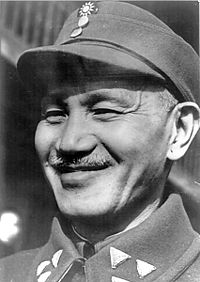
While exiled in Japan in 1914 , Sun established the Chinese Revolutionary Party, but many of his old revolutionary comrades, including Huang Xing, Wang Jingwei, Hu Hanmin and Chen Jiongming, refused to join him or support his efforts in inciting armed uprising against Yuan Shikai. In order to join the Chinese Revolutionary Party, members must take an oath of personal loyalty to Sun, which many old revolutionaries regarded as undemocratic and contrary to the spirit of the revolution. Thus, many old revolutionaries did not join Sun's new organization, and he was largely sidelined within the Republican movement during this period. Sun returned to China in 1917 to establish a rival government at Guangzhou, but was soon forced out of office and exiled to Shanghai. There, with renewed support, he resurrected the KMT on October 10, 1919, but under the name of the Chinese Kuomintang, as the old party had simply been called the Kuomintang. In 1920, Sun and the KMT were restored in Guangdong. In 1923 , the KMT and its government accepted aid from the Soviet Union after being denied recognition by the western powers. Soviet advisers – the most prominent of whom was Mikhail Borodin, an agent of the Comintern – began to arrive in China in 1923 to aid in the reorganization and consolidation of the KMT along the lines of the Communist Party of the Soviet Union, establishing a Leninist party structure that lasted into the 1990s. The Chinese Communist Party (CCP) was under Comintern instructions to cooperate with the KMT, and its members were encouraged to join while maintaining their separate party identities, forming the First United Front between the two parties.
Soviet advisers also helped the Nationalists set up a political institute to train propagandists in mass mobilization techniques, and in 1923 Chiang Kai-shek, one of Sun's lieutenants from the Tongmenghui days, was sent to Moscow for several months' military and political study. At the first party congress in 1924 , which included non-KMT delegates such as members of the CCP, they adopted Sun's political theory, which included the Three Principles of the People - nationalism, democracy, and people's livelihood.
War
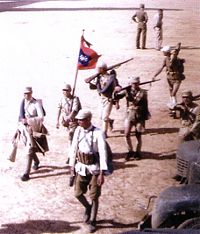
Following the death of Sun Yat-sen, General Chiang Kai-shek emerged as the KMT leader and launched the Northern Expedition in 1926 to defeat the northern warlords and unite China under the party. He halted briefly in Shanghai in 1927 to purge the Communists who had been allied with the KMT, which sparked the Chinese Civil War. When Kuomintang forces took Beijing, as the city was the de jure internationally recognized capital, though previously controlled by the feuding warlords, this event allowed the Kuomintang to receive widespread diplomatic recognition in the same year. The capital was moved from Beijing to Nanjing, the original capital of the Ming Dynasty, and thus a symbolic purge of the final Qing elements. This period of KMT rule in China between 1927 and 1937 became known as the Nanjing decade.
In sum, the KMT began as a heterogeneous group advocating American-inspired federalism and provincial independence. However, after its reorganization along Soviet lines, the party aimed to establish a centralized one party state with one ideology - Three Principles of the People. This was even more evident following Sun's elevation into a cult figure after his death. The control by one single party began the period of "political tutelage," whereby the party was to control the government while instructing the people on how to participate in a democratic system. After several military campaigns and with the help of German military advisors (German planned fifth "extermination campaign"), the Communists were forced to withdraw from their bases in southern and central China into the mountains in a massive military retreat known famously as the Long March, an undertaking which would eventually increase their reputation among the peasants. Out of the 86,000 Communist soldiers that broke out of the pocket, only 20,000 would make the 10,000km march to Shaanxi province. The Kuomintang continued to attack the Communists. This was in line with Chiang's policy of solving internal conflicts (warlords and communists) before fighting external invasions (Japan). However after Chiang was physically confined during the Xi'an Incident in 1937, the KMT together with the Communists cooperated for total war on the Japanese. The Second Sino-Japanese War had officially started, and would last until the Japanese surrender in 1945. However in many situations the alliance was in name only; after a brief period of cooperation, the armies began to fight the Japanese separately, rather than as coordinated allies. Conflicts between KMT and communists were still common during the war.
Full-scale civil war between the Communists and KMT resumed after the defeat of Japan. Chiang Kai-shek ordered his forces to defend the urbanized cities. This decision gave the Communists a chance to move freely through the countryside. At first, the KMT had the edge with the aid from the United States of weapons and ammunition. However, with hyperinflation, suspension of American aid, corruption, and thousands of deserted soldiers, the KMT lost popularity among the people. By the end of 1949 , the Communists gained the edge and controlled almost all of mainland China, as the KMT retreated to Taiwan with a significant amount of China's national treasures and 2 million people, including military forces and refugees. Some party members stayed in the mainland and broke away from the main KMT to found the Revolutionary Committee of the Kuomintang, which still currently exists as one of the eight minor registered parties in the People's Republic of China.
KMT in Taiwan
In 1895 , Taiwan, including the Pescadores, became a Japanese colony, a concession by the Qing Empire after it lost the First Sino-Japanese War. After Japan's defeat at the end of World War II in 1945, Allied Command ordered Japan, who surrendered to the US, to surrender its troops in Taiwan to the forces of the Republic of China Kuomintang.
Taiwan was placed under the administrative control of the Republic of China by the United Nations Relief and Rehabilitation Administration (UNRRA), and the ROC put Taiwan under military occupation. Tensions between the local Taiwanese and mainlanders from mainland China increased in the intervening years culminating in a flashpoint on February 27, 1947 in Taipei when a dispute between a female cigarette vendor and an anti-smuggling officer triggered civil disorder and protests that would last for days. The uprising turned bloody and was shortly put down by the ROC Army in the 228 Incident.
Following the establishment of the People's Republic of China (PRC) on October 1, 1949, the commanders of the PRC People's Liberation Army believed that Kinmen and Matsu had to be taken before a final assault on Taiwan. KMT fought the Battle of Kuningtou and stopped the invasion. In 1950 Chiang took office in Taipei under the Temporary Provisions Effective During the Period of Communist Rebellion. The provision declared martial law in Taiwan and halted some democratic processes, including presidential and parliamentary elections, until the mainland could be recovered from the Communists. KMT estimated it would take 3 years to defeat the Communists. The slogan was "prepare in the first year, start fighting in the second, and conquer in the third year." However, various factors, including international pressure, are believed to have prevented the KMT from militarily engaging the Communists full-scale. A cold war with a couple of minor military conflicts was resulted in the early years. The various government bodies previously in Nanjing were re-established in Taipei as the KMT-controlled government actively claimed sovereignty over all China. The Republic of China in Taiwan retained China's seat in the United Nations until 1971 .
Until the 1970s, KMT successfully pushed ahead with land reforms, developed the economy, implemented a democratic system in a lower level of the government, improved cross-Taiwan Strait relations, and created the admirable Taiwan economic miracle. However KMT controlled the government under a one-party authoritarian state until reforms in the late 1970s through the 1990s. As a result of the 228 Incident in 1947 , Taiwanese people had to endure what is called the "White Terror," a KMT-led political repression. The ROC in Taiwan was once referred to synonymously with the KMT and known simply as "Nationalist China" after its ruling party. In the 1970s, the KMT began to allow for "supplemental elections" in Taiwan to fill the seats of the aging representatives in parliament. Although opposition parties were not permitted, Tangwai (or, "outside the party") representatives were tolerated. In the 1980s, the KMT focused on transforming the government from a single-party system to a multi-party democracy one and embracing "Taiwanizing." With the founding of the Democratic Progressive Party (DPP) in 1986 , the KMT started competing against the DPP in Parliamentary elections. In 1991, martial law ceased when President Lee Teng-Hui terminated the Temporary Provisions Effective During the Period of Communist Rebellion. All parties started to be allowed to compete at all levels of elections, including the presidential election. Lee Teng-hui, the ROC's first democratically elected President and the leader of the KMT during the 1990s, announced his advocacy of "special state-to-state relations" with the PRC. The PRC associated it with Taiwan independence.
The KMT faced a split in 1994 that led to the formation of the Chinese New Party, alleged to be a result of Lee's "corruptive ruling style." The New Party has, since the purging of Lee, largely reintegrated into KMT. A much more serious split in the party occurred as a result of the 2000 Presidential election. Upset at the choice of Lien Chan as the party's presidential nominee, former party Secretary-General James Soong launched an independent bid, which resulted in the expulsion of Soong and his supporters and the formation of the People's First Party (PFP). The KMT candidate placed third behind Soong in the elections. After the election, Lee's strong relationship with the opponent became apparent. In order to prevent defections to the PFP, Lien moved the party away from Lee's pro-independence policies and became more favorable toward Chinese reunification. This shift led to Lee's expulsion from the party and the formation of the Taiwan Solidarity Union.
Current issues and challenges
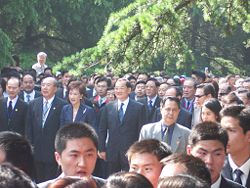
As the ruling party on Taiwan, the KMT amassed a vast business empire of banks, investment companies, petrochemical firms, and television and radio stations, thought to have made it the world's richest political party, with assets once estimated to be around US$ 2.0-10 billion [2]. Although this war chest appeared to help the KMT throughout until the mid-1990s, which led to accusations of corruption (see Black gold (politics)). After 2000 , the KMT's financial holdings appeared to be far more of a liability than an asset. After 2000, the KMT started to divest its assets. However the transactions were not disclosed and where the money earned from selling assets has gone (if it has gone anywhere) is unknown. There were accusations in the 2004 presidential election that the KMT retained assets that were illegally acquired. Currently, there is a law proposed by the DPP in the Legislative Yuan to recover illegally acquired party assets and return them to the government; however, since the pan-Blue alliance, the KMT and its smaller partner PFP, control the legislature, it is very unlikely to be passed. The KMT also acknowledged that part of its assets were acquired through extra-legal means and thus promised to "retro-endow" them to the government. However, the quantity of the assets which should be classified as illegal are still under heated debate; DPP, the current ruling party, claimed that there is much more that the KMT has yet to acknowledge. Also, the KMT actively sold assets under its title in order to quench its recent financial difficulties, which the DPP argues is illegal. Former KMT Chairman Ma Ying-Jeou's position is that the KMT will sell some of its properties at below market rates rather than return them to the government and that the details of these transactions will not be publicly disclosed.
In December 2003 , however, then-KMT chairman (present chairman emeritus) and presidential candidate, Lien Chan, initiated what appeared to some to be a major shift in the party's position on the linked questions of Chinese reunification and Taiwan independence. Speaking to foreign journalists, Lien said that while the KMT was opposed to "immediate independence," it did not wish to be classed as "pro-reunificationist" either.
At the same time, Wang Jin-pyng, speaker of the Legislative Yuan and the Pan-Blue Coalition's campaign manager in the 2004 presidential election, said that the party no longer opposed Taiwan's "eventual independence." This statement was later clarified as meaning that the KMT opposes any immediate decision on unification and independence and would like to have this issue resolved by future generations. The KMT's position on the cross-strait relationship was redefined as hoping to remain in the current neither-independent-nor-united situation.
In 2005, then-party chairman Lien Chan announced that he was to leave his office. The two leading contenders for the position include Ma Ying-jeou and Wang Jin-pyng. On April 5 2005, Taipei Mayor Ma Ying-jeou said he wishes to lead the opposition Kuomintang with Wang Jin-pyng. On 16 July 2005, Ma was elected as KMT chairman in the first contested leadership in Kuomintang's 93-year history. Some 54 percent of the party's 1.04 million members cast their ballots. Ma Ying-jeou garnered 72.4 percent of vote share, or 375,056 votes, against Wang Jin-pyng's 27.6 percent, or 143,268 votes. After failing to convince Wang to stay on as a vice chairman, Ma named holdovers Wu Po-hsiung (吳伯雄), Chiang Pin-kung (江丙坤), and Lin Cheng-chi (林澄枝), as well as long-time party administrator and strategist John Kuan (關中), as vice-chairmen; all appointments were approved by a hand count of party delegates. On February 13, 2007, Ma was indicted by the Taiwan High Prosecutors Office on charges of allegedly embezzling approximately NT$11 million (US$339,000), regarding the issue of "special expenses" while he was mayor of Taipei. Shortly after the indictment, he submitted his resignation as chairman of the Kuomintang.
There has been a recent warming of relations between the pan-blue coalition and the PRC, with prominent members of both the KMT and PFP in active discussions with officials on the Mainland. In February 2004 , it appeared that KMT had opened a campaign office for the Lien-Soong ticket in Shanghai targeting Taiwanese businessmen. However, after an adverse reaction in Taiwan, the KMT quickly declared that the office was opened without official knowledge or authorization. In addition, the PRC issued a statement forbidding open campaigning in the Mainland and formally stated that it had no preference as to which candidate won and cared only about the positions of the winning candidate.
On March 28 2005, thirty members of the Kuomintang (KMT), led by KMT vice chairman Chiang Pin-kung, arrived in mainland China, marking the first official visit by the KMT to the mainland since it was defeated by communist forces in 1949 (although KMT members including Chiang had made individual visits in the past). The delegates began their itinerary by paying homage to the revolutionary martyrs of the Tenth Uprising at Huanghuagang. They subsequently flew to the former ROC capital of Nanjing to commemorate Sun Yat-sen. During the trip KMT signed a 10-points agreement with the CPC. The opponents regarded this visit as the prelude of the third KMT-CPC cooperation. Weeks afterwards, in May, Chairman Lien Chan visited the mainland and met with Hu Jintao. No agreements were signed because Chen Shui-bian's government threatened to prosecute the KMT delegation for treason and violation of R.O.C. laws prohibiting citizens from collaborating with Communists.
Elections and results
With the party's voters defecting to both the PFP and TSU, the KMT did poorly in the December 2001 legislative elections and lost its position as the largest party in the Legislative Yuan. More recently, the party did well in the 2002 mayoral and council election with Ma Ying-jeou, its candidate for Taipei mayor, winning reelection by a landslide and its candidate for Kaohsiung mayor narrowly losing but doing surprisingly well. Since 2002 , the KMT and PFP have coordinated electoral strategies. In 2004 , the KMT and PFP ran a joint presidential ticket, with Lien running for president and Soong running for vice-president.
The loss of the presidential election of 2004 to DPP President Chen Shui-bian by merely over 30,000 votes was a bitter disappointment to party members, leading to a few rallies for a few weeks protesting alleged electoral fraud and the "odd circumstances" of the shooting of President Chen. However, the fortunes of the party were greatly improved when the KMT did well in the legislative elections held in December 2004 by maintaining its support in southern Taiwan achieving a majority for the pan-blue coalition. Soon after the election, there appeared to be a falling out with the KMT's junior partner the People's First Party and talk of a merger seemed to have ended. This split appeared to widen in early 2005, as the leader of the PFP, James Soong appeared to be reconciling with President Chen Shui-Bian and the Democratic Progressive Party. Many PFP members including legislators and municipal leaders have defected to the KMT, and the PFP is seen as a fading party.
The KMT won a decisive victory in the 3-in-1 local elections of December 2005, replacing the DPP as the largest party at the local level. This was seen as a major victory for the party ahead of legislative elections in 2007. There were elections for the 2 Municipalities of the ROC, Taipei and Kaohsiung on December 2006. The KMT won a clear victory in Taipei, but lost to the DPP in the southern city of Kaohsiung by the slim margin of 1,100 votes.
Organization
List of leaders of the Kuomintang (1912-1914)
President:
- Song Jiaoren (1912-1913)
Premier:
- Sun Yat-sen (1913-1914)
List of leaders of the Kuomintang of China (1919-present)
Premier:
- Sun Yat-sen (1919-1925)
- Zhang Renjie (1925-1926)
Chairman of Central Executive Committee:
- Hu Hanmin (1927-1931)
- Wang Jingwei (1931-1933)
- Chiang Kai-shek (1933-1938) (self-proclaimed)
Director-General:
- Chiang Kai-shek (1926-1927)
Vacancy (1927-1935) - Hu Hanmin (1935-1936)
Vacancy (1936-1938) - Chiang Kai-shek (1938-1975)
Chairman:
- Chiang Ching-kuo (1975-1988)
- Lee Teng-hui (1988-2000)
- Lien Chan (2000-2005)
- Ma Ying-jeou (2005-2007)
- Wu Po-hsiung (2007) (acting)
- Chiang Pin-kung (2007) (acting)
- Wu Po-hsiung (April 2007-present)
Current vice chairpersons
- John Kuan (關中)
- Lin Yi-shih (林益世)
- Chang Jen-Hsiang (章仁香)
- Chan Chuen-pao (詹春柏)
List of Secretaries-General of the Kuomintang of China
Seceretaries-General of the Central Executive Committee:
- Yeh Ch'u-ts'ang (1926-1927)
- Post abolished (1927-1929)
- Chen Li-fu (陳立夫) (1929-1931)
- Ting Wei-feng (1931)
- Yeh Ch'u-ts'ang (1931-1938)
- Chu Chia-hua (1938-1939)
- Yeh Ch'u-ts'ang (1939-1941)
- Wu Tieh-cheng (1941-1948)
- Cheng Yen-feng (1948-1950)
Seceretaries-General of the Central Reform Committee:
- Chang Chi-yun (1950-1952)
Seceretaries-General of the Central Committee:
- Chang Chi-yun (1952-1954)
- Chang Li-sheng (1954-1959)
- Tang Tsung (1959-1964)
- Ku Feng-hsiang (1944-1968)
- Chang Pao-shu (1968-1979)
- Chiang Yen-si (1979-1985)
- Ma Su-lei (1985-1987)
- Lee Huan (李煥) (1987-1989)
- James Soong (宋楚瑜) (1989-1993)
- Hsu Shui-teh (許水德) (1993-1996)
- Wu Po-hsiung (吳伯雄) (1996-1998)
- Chang Hsiao-yen (章孝嚴) (1998-1999)
- Huang Kun-fei (1999-2000)
- Lin Fong-cheng (林豐正) (2000-2005)
- Chan Chuen-pao (詹春柏) (2005-2007)
- Wu Tun-yi (吳敦義) (2007-present)
See also
- History of the Republic of China
- Politics of the Republic of China
- Military of the Republic of China
- Elections in the Republic of China
- List of political parties in the Republic of China
- List of assets owned by the Kuomintang
- Political divisions of the Republic of China
- Political status of Taiwan
- Revolutionary Committee of the Kuomintang
ReferencesISBN links support NWE through referral fees
- Bergere, Marie-Claire and Janet Lloyd (2000). Sun Yat-sen. Stanford, California: Stanford University Press. ISBN 0-8047-4011-9.
- Roy, Denny (2003). Taiwan: A Political History. Ithaca, New York: Cornell University Press. ISBN 0-8014-8805-2.
Notes
- ↑ Art 1, Party Charter, Kuomintang of China [1]
- ↑ "Taiwan's Kuomintang On the brink", Economist, 6th Dec. 2001.
Further reading
- Chris Taylor, "Taiwan's Seismic shift," Asian Wall Street Journal, February 4 2004 (not available online)
External links
| Main events (1916-1920) | Main events (1920-1930) | Northern Factions | Southern Factions |
|---|---|---|---|
|
|
Beiyang Army:
Regional:
|
|
| Main events pre-1945 | Main events post-1945 | Specific articles |
|---|---|---|
|
Part of the Cold War
|
Primary participants
|
| ||||||||||||||
| ||||||||||||||||||||||||||
Credits
New World Encyclopedia writers and editors rewrote and completed the Wikipedia article in accordance with New World Encyclopedia standards. This article abides by terms of the Creative Commons CC-by-sa 3.0 License (CC-by-sa), which may be used and disseminated with proper attribution. Credit is due under the terms of this license that can reference both the New World Encyclopedia contributors and the selfless volunteer contributors of the Wikimedia Foundation. To cite this article click here for a list of acceptable citing formats.The history of earlier contributions by wikipedians is accessible to researchers here:
The history of this article since it was imported to New World Encyclopedia:
Note: Some restrictions may apply to use of individual images which are separately licensed.
